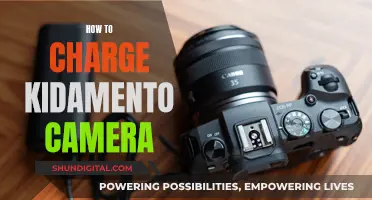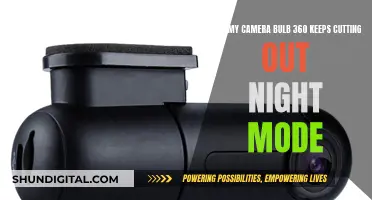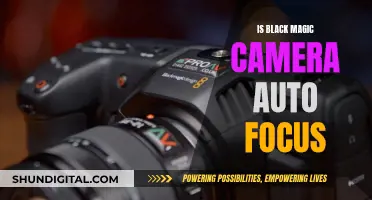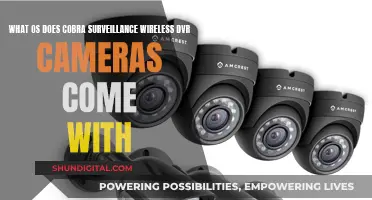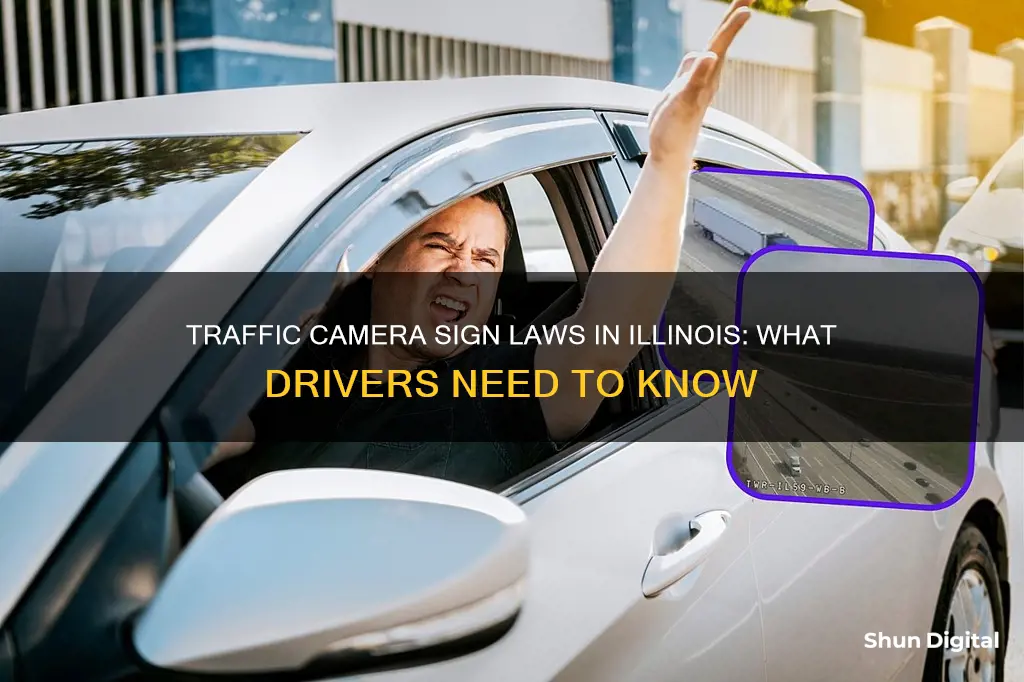
Traffic cameras are an important tool for monitoring driving behavior and enforcing traffic laws. In Illinois, these cameras are commonly used to detect and deter red-light violations, with a focus on improving road safety and reducing accidents. While Illinois state law imposes specific requirements on the use of red-light cameras, it is worth investigating whether the state or local jurisdictions require the presence of traffic camera signs to be explicitly indicated. Understanding the regulations surrounding traffic camera signage in Illinois can help drivers be aware of their rights and responsibilities when navigating the state's roads and intersections.
| Characteristics | Values |
|---|---|
| Purpose of Traffic Cameras | To increase safety on streets by reducing crashes, especially dangerous angle crashes, and to reduce red light running. |
| Camera Locations | Installed at intersections with a high number of crashes, particularly "T-bone" crashes, and based on community input and support. |
| Warning Signs | Warning signs are posted on all approaches to an intersection with automated red light cameras. |
| Camera Operation | Third parties operate most cameras, making access to footage difficult. |
| Footage Availability | Footage is available for review for 30 days after a violation. |
| Red Light Violation | Entering an intersection after the signal has turned red. |
| Fine Amount | $100 for a red light camera ticket, increasing to $200 if paid late. |
| Administrative Violation | Red light camera violations are considered administrative violations, similar to parking tickets, and do not affect driving records or insurance rates. |
What You'll Learn

Illinois requires signs at intersections with traffic cameras
Illinois has strict laws regarding traffic violations, and the state uses several methods to monitor driving behavior and enforce traffic rules. One notable method is the use of traffic cameras, particularly at intersections, to capture images of vehicles and motorists who break traffic laws. These traffic cameras are installed in several counties across Illinois, including Cook, Lake, Kane, DuPage, McHenry, Will, Madison, and St. Clair.
The presence of traffic cameras, especially at intersections, is a significant concern for motorists in Illinois. The state has specific requirements for the use of red-light cameras, which are often implemented to improve road safety and reduce crashes. According to Illinois law, jurisdictions that use red-light cameras must meet certain obligations. These include making available multiple images or a video of the violation to the vehicle owner online, providing written notification of the violation within 90 days, and including the date, time, and location of the infraction with the images.
To address your specific query, yes, Illinois does require signs at intersections with traffic cameras. The Illinois Vehicle Code (625 ILCS 5/11-208.6) mandates that municipalities operating automated traffic law enforcement systems, such as red-light cameras, must post clear signs indicating the presence of these systems. The City of Chicago, for example, posts signs warning drivers of photo enforcement on all approaches to an intersection with automated red-light cameras. This practice is in line with the requirements specified in the Illinois Vehicle Code and the recommendations outlined in the Manual on Uniform Traffic Control Devices (MUTCD).
The presence of these signs is essential for several reasons. Firstly, it helps to improve transparency and ensure that drivers are aware of the enforcement measures in place. Additionally, the signs serve as a deterrent, encouraging drivers to obey traffic signals and reduce violations, ultimately contributing to the overall goal of enhancing road safety and preventing accidents.
In conclusion, Illinois takes road safety seriously and utilizes various tools, including traffic cameras, to enforce traffic laws and reduce crashes. The state recognizes the importance of notifying drivers about the presence of these cameras through proper signage, as outlined in the relevant codes and regulations. By doing so, Illinois aims to create a safer driving environment for all motorists and pedestrians.
Charging the DJI Osmo Action Camera: A Quick Guide
You may want to see also

Red light camera footage is available for 30 days
In Chicago, 24-hour streaming video footage from red light cameras is available for review for 30 days. This footage can be viewed on the City of Chicago website, specifically on the finance page. To access the footage, you will need your ticket number and license plate number.
Red light camera footage is typically used to enforce traffic laws and issue tickets to drivers who run red lights. These cameras are mounted on traffic lights at busy intersections and capture multiple images of the traffic violation, including the vehicle's license plate, driver, and offence. While the primary purpose of red light cameras is not to provide evidence for traffic accidents, the footage can be useful in proving fault in the event of a crash.
In Illinois, there are specific requirements for the use of red light cameras. Jurisdictions must make the footage available to the vehicle owner online and provide written notification of the violation within 90 days. Additionally, signs must be posted at intersections with automated red light enforcement to warn drivers that the intersection is being monitored.
It is important to note that ignoring a red light camera ticket can result in additional fines and even vehicle seizure by the City of Chicago. Therefore, it is advisable to take prompt action upon receiving a ticket.
Fight Speeding Camera Tickets: Your Legal Rights and Strategies
You may want to see also

Red light camera tickets are $100
In Illinois, red light camera tickets are $100. These tickets are issued when a vehicle is caught driving through a red light, with multiple images taken to show the different stages of the traffic violation. The ticket is sent to the owner of the vehicle, regardless of who was driving, and must be paid within 30 days. If the ticket is not paid on time, the fine increases to $200.
Red light cameras are typically mounted on traffic lights at busy intersections and are in heavy use in Illinois, particularly in the Chicago area. These cameras are designed to increase road safety and reduce dangerous crashes, specifically "angle crashes" or "T-bone crashes", which often result in serious injuries or fatalities. The cameras are activated when a vehicle crosses the crosswalk line on a red light, capturing both still photographs and video footage of the violation.
In addition to the fine, failing to pay a red light camera ticket in Illinois can result in vehicle seizure by the city of Chicago. While these tickets do not result in points on your driving record, ignoring them can lead to further penalties and increased fines. It is important to be aware of the presence of these cameras and to abide by traffic rules to avoid incurring penalties.
To dispute a red light camera ticket in Illinois, individuals can review the video and photographic evidence online. However, it is challenging to dispute these tickets, and ignoring them can result in additional consequences. It is advisable to pay the ticket within the given timeframe or take the necessary legal action to dispute the violation.
While red light camera tickets in Illinois are a flat rate of $100, other states may have different fine amounts. For example, in Yonkers, New York, the fine for a red light camera violation is $65, with a late penalty of $25 if not paid within 30 days. It is important to be aware of the specific rules and regulations regarding traffic violations in each state.
Ft. Worth's Stance on Red-Light Camera Tickets
You may want to see also

No points on your license for red light violations
In Illinois, red light cameras are typically installed at busy intersections in metro areas to capture vehicles that drive through a red light. These cameras take multiple images of the violation, clearly showing the license plates, driver, and offence. While these cameras are meant to enhance road safety, they can also catch you running a red light, resulting in a ticket.
Fortunately, no points will be added to your license for red light violations in Illinois. These tickets are considered administrative violations, similar to parking tickets, and will not appear on your driving record. You can breathe a sigh of relief as your car insurance rates will not increase due to this type of violation. However, ignoring a red light camera ticket can lead to more fines and even vehicle seizure if not addressed promptly.
The fine for a red light camera ticket in Illinois is $100 if paid within the given time frame, which is generally 30 days from the date of issue. If you fail to pay by the deadline, the fine increases to $200. It's important to take care of this fine sooner rather than later to avoid additional penalties.
While red light camera tickets don't result in points, they can still be costly and should not be taken lightly. It's important to abide by traffic rules and signals to ensure your safety and the safety of others on the road.
In addition to the use of red light cameras, Illinois has implemented specific rules regarding red light violations. For instance, motorists are permitted to make a right turn after stopping at a red light, provided there is no sign prohibiting it. However, they must follow right-of-way rules and exercise caution. Similarly, a left turn after stopping at a red light is only allowed when turning from a one-way street onto another one-way street, and normal right-of-way rules must be followed.
Understanding the Creative Power of TV Mode on Your Camera
You may want to see also

Automated enforcement cameras are allowed in 8 counties
In Illinois, some jurisdictions use automated cameras at intersections to detect red-light violators. These cameras are triggered by vehicles entering the intersection above a preset minimum speed and after a specified time following a red signal. The cameras record both still photographs and video footage of the vehicle, including the rear license plate. While these cameras are in use in Illinois, there is no explicit mention of whether traffic camera signs are required.
Automated enforcement cameras are permitted in eight counties in Illinois. These cameras are intended to improve road safety and reduce dangerous crashes, particularly "T-bone" crashes, which often result in serious injuries or fatalities. The use of these cameras is regulated by state law, which imposes specific requirements. For instance, jurisdictions must make the footage of the violation available to the vehicle owner online and notify them in writing within 90 days. Additionally, signs must be posted to warn drivers of the presence of automated enforcement cameras.
The use of automated enforcement cameras in Illinois has been a subject of debate. Proponents argue that these cameras enhance road safety by discouraging motorists from running red lights and reducing the severity of crashes. On the other hand, critics argue that these cameras invade privacy and are primarily used as a revenue source rather than a safety measure.
The effectiveness of automated enforcement cameras has been studied, and research suggests that they can reduce crashes and improve safety. For example, a study in Charlotte, North Carolina, found that a mobile camera enforcement program reduced total and fatal crashes by 19% and 17%, respectively. Another study in Scottsdale, Arizona, showed that a fixed camera enforcement program decreased total target crashes by 44% to 54%, injury crashes by 28% to 48%, and property damage crashes by 46% to 56%.
In conclusion, while there is no explicit mention of traffic camera signs being required in Illinois, automated enforcement cameras are permitted in eight counties and are subject to specific regulations. These cameras have been implemented to improve road safety, and studies suggest they can be effective in reducing crashes. However, the use of these cameras has also sparked debates about privacy and revenue generation.
Toledo Traffic Camera Tickets: What's the Fine for Not Paying?
You may want to see also
Frequently asked questions
No, but they are allowed. The Illinois Vehicle Code permits the use of automated enforcement using cameras to capture images of vehicles and the motorist committing a traffic law violation.
The State of Illinois Vehicle Code requires municipalities operating automated traffic law enforcement systems to assess the safety impact of each system using the best available data and make the analysis available to the public. Jurisdictions using red-light cameras must also make images or videos of the violation available to the vehicle owner online, include the date, time, and location of the violation, and notify the vehicle owner in writing within 90 days.
The fine for a red-light camera ticket in Illinois is $100, increasing to $200 if paid late. The conviction will also add 20 demerit points to the motorist's driving record, but eligible drivers can keep the conviction off their record by completing traffic school.



